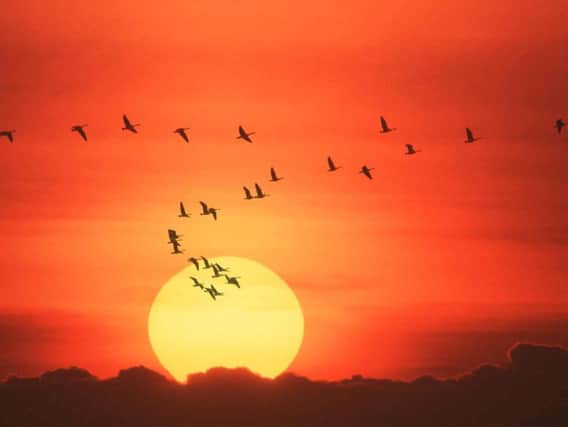8 signs and customs that mark the end of Scottish summer


Outside, evening light fades quickly and streets become quieter as children - already wearing their back to school jumpers and heavy shoes, retreat indoors. Lamps are switched on, food becomes warmer and that familiar need to get cosy starts to edge in ever so subtly.
Scots - long in tune with seasonal changes - have a variety of ways to mark the changing calendar, particularly when the shifting seasons had a fundamental role in wealth and health of farming communities.
Advertisement
Hide AdAdvertisement
Hide AdHere we look at the signs, rituals and traditions of the end of summer in Scotland.:
1. The geese are coming
The sound of honking geese signals the change in season with Pink Footed Geese, among others, migrating in their thousands from the freezing Arctic to warmer climes to eat and breed.
The first noise of these arrivals to many symbolises the onset of the long, dark winter and is met with mixed emotion.
Geese have recently been seen - and heard - on the move all over Scotland but they are not our friends from the far north - not yet, anyway.
They are more likely to be Canada Geese, long resident here, who have been on a kind of 'mock migratory' run to shed their heavy flying feathers.
Typical destinations for these birds include the Beauly Firth, which offers a good clear aspect where they can look out for predators and quickly molt.
The Arctic visitors usually arrive next month. At Montrose Basin, they come around September 14 - proof there is still some summer left to enjoy.
2. The robin changes it song
The robin is one of the few birds in the UK that sing all year round. Autumn and spring songs are distinctly different.
Advertisement
Hide AdAdvertisement
Hide AdThe autumn song starts after the moult, from late summer onwards when the bird is looking for its winter territory.
It is more subdued and melancholy in its tone, while the spring song is powerful, confident and upbeat.
You'll probably see robins looking for their winter home around now.
3. A piece of lucky cheese
Traditionally in Scotland, many rituals surrounded the advent of Lammas Day, which falls on August 1 and signals the beginning of the wheat harvest and the beginning of autumn.
It was also the day when cattle were brought down from summer pasture back to the strath by the women and children who typically relocated to shielings with their animals for the warmer season.
To mark Lammas Day, a piece of "removal cheese" was made from the last day's milk to give to the children for luck in the coming months.
4. Hair in the milk
It was an ancient custom in the Highlands and Islands that on Lammas Day a ball of hair was put in the milk pail to
help keep it good and strong and protect it from dark spirits. There was a long held belief that witches were able to
steal milk and create hardships for families.
5. No fire
Advertisement
Hide AdAdvertisement
Hide AdLammas Day, the start of autumn, was also a quarter day - the first day of every quarter of the year which also includes New Year day, St Bride's Day and Beltane.
On these days, it was forbidden that any materials to make a fire should leave the house, not even for a neighbour. It was feared that anyone who took the fire would also take the goodness from the milk of the cows of that home.
6. Saining straw
Also on Lammas Day, a wisp of straw was taken to sprinkle the houses with a lucky liquid, usually water that had come into contact with silver or gold, such as a wedding ring, in order to protect the home and its family from harm during the season ahead.
7. Disappearing swifts and other birds
Swifts are one of the earliest migrants to head south and have mostly gone by the end of August. Swallows and house martins can also be seen gathering, often on power lines, before starting the long flight south.
8. Autumn storms
Forecasters earlier warned of an "early Autumn" in Scotland with four Atlantic storms sweeping in this month. Those westerly blows are a sure sign of the changing season. Changes are already being seen in leaves in some parts, with the very beginnings of the spectacular autumn display of reds, russets and golds starting to show.
Thanks to Scottish Wildlife Trust for their contributions
